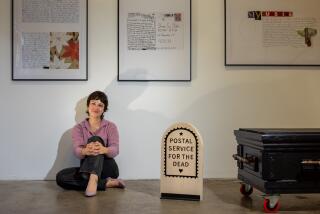Fun with their stamp on it
- Share via
MORE than a century before technology-inspired treasure hunters put geocaching on the map, British hobbyists known as “letterboxers” headed out on their own trails.
An outdoor activity not unlike treasure hunting, letterboxing has its roots in the craggy moorland of mid-19th century Devon, England. It is said that “Letterbox 1” was the result of a hiking guide having left a well-hidden container of letters, presumably written to subsequent hikers, along a trail -- thus the name “letterboxing.” This evolved into enthusiasts’ placing notebooks and rubber stamps in containers sought out via clues spread through word of mouth and published in a catalog. When searchers found a spot, they used their own rubber stamps to mark the notebook, and the stamp in the container to mark their notebooks. A little-known open-air hobby was born.
Today, people of all ages, in Southern California and beyond, unobtrusively participate in the pastime -- albeit with a 21st century twist, as the World Wide Web offers a link to the great wide open.
Letterboxing aficionados post and read clue lists and directions that are placed -- most often anonymously, using a made-up name -- on websites such as Letterboxing North America and Atlas Quest. They then set out to locales such as overlooks or public gardens in search of well-hidden letterboxes, which these days are small waterproof plastic containers such as vitamin bottles and Tupperware.
Unlike in geocaching, the containers don’t hold trinket treasures meant to be traded. Instead, inside are a rubber stamp and a small journal. Visiting letterboxers come equipped with their own journal and “signature stamp.” When they have sufficiently surveyed the scene to ascertain that no outsiders are watching, they stamp their journal with the box stamp and the box journal with their stamp.
Beyond the rules and technicalities, letterboxing seems founded on a liberating thirst for discovery and a desire to explore one’s creativity. The sometimes-handmade stamps found in the boxes often relate to whatever theme a given journey might have. For example, a feather adorns one in the Feather Falls area of La Canada Flintridge’s Descanso Gardens. Some clue lists double as historic tours of areas such as Old Hollywood or Will Rogers State Historic Park . Others follow pop culture via shooting locations of the Bat Cave from the 1960s “Batman” TV series or locales in “E.T. the Extra-Terrestrial.”
Some, such as public relations executive Lynne Doll of Glendale, believe that when it comes to this pastime, it’s the journey, not just the destination. “I have lived in Southern California my whole life,” she says. “Letterboxing has taken me to parts of Griffith Park that I’ve never been to.” Doll, who discovered the hobby through a friend, Stephanie Irey, goes on letterboxing treks with her husband, daughter and daughter’s Brownie troop.
Irey, who runs a catering company in Pasadena, enjoys the destination reward even more than the letterboxing journey. Finding the letterbox, she says, gave her young son and his friends the incentive to experience nature: “It was an added benefit to be able to do something outdoors.” She and her husband have also taken the activity across state and country lines. “We traveled to Montreal a couple of years ago, so we looked for letterboxes there,” she says. “That’s something that’s always in our mind when we travel, because they’re all over the world.”
One such traveler, a 40-year-old musician and music teacher who prefers to identify herself by her online letterboxing name, “Kantexan,” brought her passion for the hobby from her home near Dallas to a former zoo in Los Angeles while visiting this summer. The online clues to her L.A. box read like an Edgar Allan Poe tale:
“You will soon hear the ghostly roars of lions, tigers and bears long since gone. After you pass these cages you will see a set of eight wide cement steps going down the hill on your right with a metal railing down the center of them.”
Anonymity and secrecy are quite clearly prerequisites in this hobby. “We like the mystery of it,” Doll says.
“When you are searching for a box you have no idea what the planter’s race, sex, religion or age is,” says Kantexan, whose identifying stamp is a seahorse. The activity, apart from get-togethers, requires little to no in-person interaction.
There is nevertheless a kind of fierce and at times outsider-wary solidarity. Some “silverbacks,” as the veteran hobbyists dub themselves, shun publicity, fearing that the nuances of letterboxing will be lost in the media. One such concern is that wannabe letterboxers will not be secretive enough to keep outside observers from damaging or stealing the boxes. Such alleged interlopers are known in the community as “noxers” (nonletterboxers). True letterboxers are required to care for their boxes and report when others have been damaged or gone missing.
Yet members of the community will be the first to explain that the hobby’s contemporary U.S. incarnation was born through the media. An article on letterboxing in England published in a 1998 issue of Smithsonian magazine first piqued the interest of would-be letterboxers in the U.S., beginning full-throttle in the Northeast and expanding into California.
Some of the hobby’s adherents see its longevity as contingent on sharing it with other (stealthy and discreet) individuals. Kantexan adds: “Perhaps historians may look back and consider [letterboxing] one of the most widespread folk-art movements of the 21st century.” Or perhaps they’ll keep quiet, for fear of revealing too much of a cleverly hidden secret.
*
Where to learn more
Letterboxers relish the obscurity of their hobby, but these two sites delve into it:
Letterboxing North America, at www.letterboxing.org: Features how-to articles for beginners, and clue postings by North American regions.
Atlas Quest, at www.atlasquest.com: Information ranging from tutorials to member boards, servicing global letterboxers from Aruba to Zimbabwe.
More to Read
Sign up for The Wild
We’ll help you find the best places to hike, bike and run, as well as the perfect silent spots for meditation and yoga.
You may occasionally receive promotional content from the Los Angeles Times.






